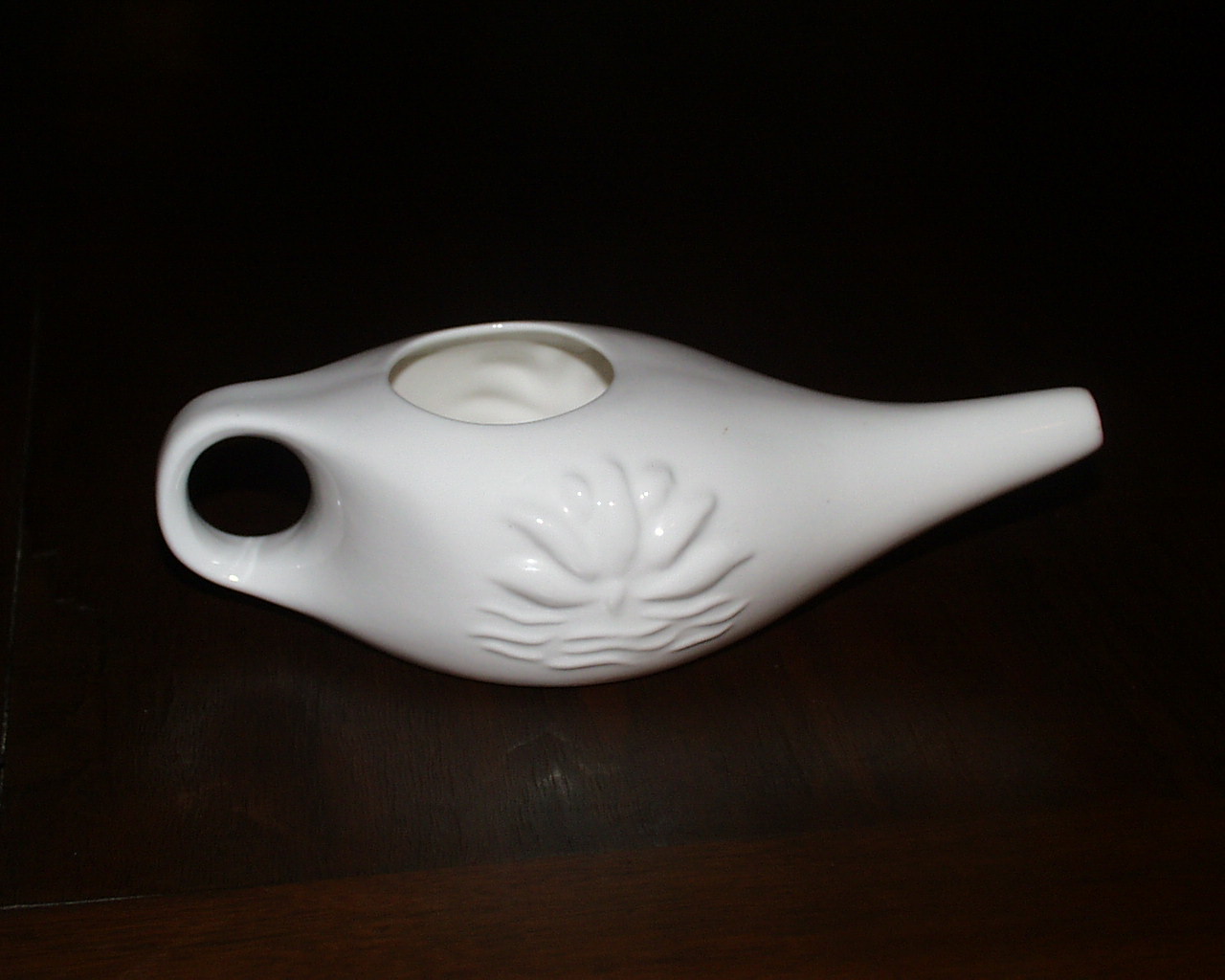|
Neti (Hatha Yoga)
Neti (Sanskrit: नेती ''netī'') is an important part of Shatkarma (sometimes known as Shatkriya), the Hindu yogic system of body cleansing techniques. It can have universal application, irrespective of their religion. It is intended mainly to clean the air passageways in the head. Both the Hatha Yoga Pradipika and other sources usually attribute to Neti many beneficial effects that range from profound physiological ones on the body, mind and personality to even clairvoyance. The two main variants are jala neti (जलनेति) using water and the more advanced sutra neti (सूत्रनेति) using string. Jala neti For this technique, sterilized and lukewarm tonicity, isotonic saline solution, salt water is poured into one nostril, so that it leaves through the other. The procedure is then repeated on the other side, and the nose is dried by bending forward and by rapid breathing. [...More Info...] [...Related Items...] OR: [Wikipedia] [Google] [Baidu] |
Neti Pot
Nasal irrigation (also called nasal lavage, nasal toilet, or nasal douche) is a personal hygiene practice in which the nasal cavity is washed to flush out mucus and debris from the Human nose, nose and sinuses, in order to enhance Obligate nasal breathing, nasal breathing. Nasal irrigation can also refer to the use of Saline spray, saline nasal spray or nebulizers to moisten the mucous membranes. Medical uses Nasal irrigation can be an effective therapy to relieve symptoms of acute sinusitis caused by upper respiratory tract infections such as the common cold. The evidence for effectiveness in relieving chronic sinusitis is weak. It can also be useful for the temporary relief of the symptoms associated with allergic rhinitis. Adverse effects Adverse effects include nasal irritation, nosebleeds, headache, and drainage after the irrigation is done. It is generally well tolerated. There is a risk of infection if the water is not sterile or the device is not cleaned after us ... [...More Info...] [...Related Items...] OR: [Wikipedia] [Google] [Baidu] |
Sanskrit
Sanskrit (; stem form ; nominal singular , ,) is a classical language belonging to the Indo-Aryan languages, Indo-Aryan branch of the Indo-European languages. It arose in northwest South Asia after its predecessor languages had Trans-cultural diffusion, diffused there from the northwest in the late Bronze Age#South Asia, Bronze Age. Sanskrit is the sacred language of Hinduism, the language of classical Hindu philosophy, and of historical texts of Buddhism and Jainism. It was a lingua franca, link language in ancient and medieval South Asia, and upon transmission of Hindu and Buddhist culture to Southeast Asia, East Asia and Central Asia in the early medieval era, it became a language of religion and high culture, and of the political elites in some of these regions. As a result, Sanskrit had a lasting effect on the languages of South Asia, Southeast Asia and East Asia, especially in their formal and learned vocabularies. Sanskrit generally connotes several Indo-Aryan languages# ... [...More Info...] [...Related Items...] OR: [Wikipedia] [Google] [Baidu] |
Shatkarma
The shatkarmas (Sanskrit: षटकर्म ''ṣaṭkarma'', literally ''six actions''), also known as shatkriyas,Shatkarmas - Cleansing Techniques in Yoga Magazine, a publication of are a set of purifications of the body, to prepare for the main work of yoga towards (liberation). These practices, outlined by |
Hatha Yoga Pradipika
The ''Haṭha Yoga Pradīpikā'' ( or Light on Hatha Yoga) is a classic fifteenth-century Sanskrit manual on haṭha yoga, written by Svātmārāma, who connects the teaching's lineage to Matsyendranath of the Nathas. It is among the most influential surviving texts on haṭha yoga, being one of the three classic texts alongside the ''Gheranda Samhita'' and the ''Shiva Samhita''. More recently, eight works of early hatha yoga that may have contributed to the ''Hatha Yoga Pradipika'' have been identified. Title and composition Different manuscripts offer different titles for the text, including ''Haṭhayogapradīpikā'', ''Haṭhapradīpikā'', ''Haṭhapradī'', and ''Hath-Pradipika''. It was composed by Svātmārāma in the 15th century as a compilation of the earlier haṭha yoga texts. Svātmārāma incorporates older Sanskrit concepts into his synthesis. He introduces his system as a preparatory stage for physical purification before higher meditation or Raja Yoga. S ... [...More Info...] [...Related Items...] OR: [Wikipedia] [Google] [Baidu] |
Yoga Magazine
The Bihar School of Yoga is a modern school of yoga founded and developed by Sri Swami Satyananda Saraswati in Munger, Bihar, India, in 1963. The system of yoga taught at the school is recognized worldwide as Bihar Yoga or the Satyananda Yoga tradition. In 2019, the school was awarded the Prime Minister’s Award for Outstanding Contribution Towards Promotion and Development of Yoga. History Swami Satyananda inaugurated the Bihar School of Yoga (BSY) on 19 January 1964, Vasant Panchami, by lighting the akhanda jyoti (eternal flame) as a dedication to his guru, Swami Sivananda Saraswati. The school became a centre of Yoga training from the mid-1960s: Regular fifteen-day and one-month courses were conducted in Munger, as well as a six-month sadhana course and a nine-month International Teacher Training course in 1967. In 1968, to propagate the school's teachings, Swami Satyananda went on his first world tour to Malaysia, Singapore, Australia, Japan, USA, Canada, England, France, ... [...More Info...] [...Related Items...] OR: [Wikipedia] [Google] [Baidu] |
Bihar School Of Yoga
The Bihar School of Yoga is a modern school of yoga founded and developed by Sri Swami Satyananda Saraswati in Munger, Bihar, India, in 1963. The system of yoga taught at the school is recognized worldwide as Bihar Yoga or the Satyananda Yoga tradition. In 2019, the school was awarded the Prime Minister’s Award for Outstanding Contribution Towards Promotion and Development of Yoga. History Swami Satyananda inaugurated the Bihar School of Yoga (BSY) on 19 January 1964, Vasant Panchami, by lighting the akhanda jyoti (eternal flame) as a dedication to his guru, Swami Sivananda Saraswati. The school became a centre of Yoga training from the mid-1960s: Regular fifteen-day and one-month courses were conducted in Munger, as well as a six-month sadhana course and a nine-month International Teacher Training course in 1967. In 1968, to propagate the school's teachings, Swami Satyananda went on his first world tour to Malaysia, Singapore, Australia, Japan, USA, Canada, England, Fra ... [...More Info...] [...Related Items...] OR: [Wikipedia] [Google] [Baidu] |
Clairvoyance
Clairvoyance (; ) is the claimed ability to acquire information that would be considered impossible to get through scientifically proven sensations, thus classified as extrasensory perception, or "sixth sense". Any person who is claimed to have such ability is said to be a clairvoyant () (). Claims for the existence of paranormal and psychic abilities such as clairvoyance have not been supported by scientific evidence.Robert Todd Carroll, Carroll, Robert Todd. (2003)"Clairvoyance" Retrieved 2014-04-30. Parapsychology explores this possibility, but the existence of the paranormal is not accepted by the scientific community. The scientific community widely considers parapsychology, including the study of clairvoyance, a pseudoscience. Usage Pertaining to the ability of clear-sightedness, clairvoyance refers to the paranormal ability to see persons and events that are distant in time or space. It can be divided into roughly three classes: precognition, the ability to perceive o ... [...More Info...] [...Related Items...] OR: [Wikipedia] [Google] [Baidu] |
Tonicity
In chemical biology, tonicity is a measure of the effective osmotic pressure gradient; the water potential of two Solution (chemistry), solutions separated by a Semipermeable membrane, partially-permeable cell Cell membrane, membrane. Tonicity depends on the relative concentration of selective membrane-impermeable solutes across a cell membrane which determine the direction and extent of osmotic flux. It is commonly used when describing the swelling-versus-shrinking response of cell (biology), cells immersed in an external solution. Unlike osmotic pressure, tonicity is influenced only by solutes that cannot cross the membrane, as only these exert an effective osmotic pressure. Solutes able to freely cross the membrane do not affect tonicity because they will always equilibrate with equal concentrations on both sides of the membrane without net solvent movement. It is also a factor affecting imbibition. There are three classifications of tonicity that one solution can have rela ... [...More Info...] [...Related Items...] OR: [Wikipedia] [Google] [Baidu] |
Saline Solution
Saline (also known as saline solution) is a mixture of sodium chloride (salt) and water. It has a number of uses in medicine including cleaning wounds, removal and storage of contact lenses, and help with dry eyes. By injection into a vein, it is used to treat hypovolemia such as that from gastroenteritis and diabetic ketoacidosis. Large amounts may result in fluid overload, swelling, acidosis, and high blood sodium. In those with long-standing low blood sodium, excessive use may result in osmotic demyelination syndrome. Saline is in the crystalloid family of medications. It is most commonly used as a sterile 9 g of salt per litre (0.9%) solution, known as ''normal saline''. Higher and lower concentrations may also occasionally be used. Saline is acidic, with a pH of 5.5 (due mainly to dissolved carbon dioxide). The medical use of saline began around 1831. It is on the World Health Organization's List of Essential Medicines. In 2022, sodium salts was the 216th mo ... [...More Info...] [...Related Items...] OR: [Wikipedia] [Google] [Baidu] |
Sinus (anatomy)
A sinus is a sac or cavity in any organ or tissue, or an abnormal cavity or passage. In common usage, "sinus" usually refers to the paranasal sinuses, which are air cavities in the cranial bones, especially those near the nose and connecting to it. Most individuals have four paired cavities located in the cranial bone or skull. Etymology ''Sinus'' is Latin for "bay", "pocket", "curve", or "bosom". In anatomy, the term is used in various contexts. The word "sinusitis" is used to indicate that one or more of the membrane linings found in the sinus cavities has become inflamed or infected. It is however distinct from a fistula, which is a tract connecting two epithelial surfaces. If left untreated, infections occurring in the sinus cavities can affect the chest and lungs. Sinuses in the body * Paranasal sinuses ** Maxillary ** Ethmoid ** Sphenoid ** Frontal * Dural venous sinuses ** Anterior midline *** Cavernous *** Superior petrosal *** Inferior petrosal ** Central sul ... [...More Info...] [...Related Items...] OR: [Wikipedia] [Google] [Baidu] |
Nasal Polyp
Nasal is an adjective referring to the nose, part of human or animal anatomy. It may also be shorthand for the following uses in combination: * With reference to the human nose: ** Nasal administration, a method of pharmaceutical drug delivery ** Nasal emission, the abnormal passing of oral air through a palatal cleft, or from some other type of pharyngeal inadequacy ** Nasal hair, the hair in the nose * With reference to phonetics: ** Nasalization, the production of a sound with a lowered velum, allowing some of the air to escape through the nose; the resulting being either: *** a nasal consonant, or *** a nasal vowel * With reference to the nose of humans or other animals: ** Nasal bone, two small oblong bones placed side by side at the middle and upper part of the face, and form, by their junction, "the bridge" of the nose ** Nasal cavity, a large air filled space above and behind the nose in the middle of the face ** Nasal concha, a long, narrow and curled bone shel ... [...More Info...] [...Related Items...] OR: [Wikipedia] [Google] [Baidu] |




